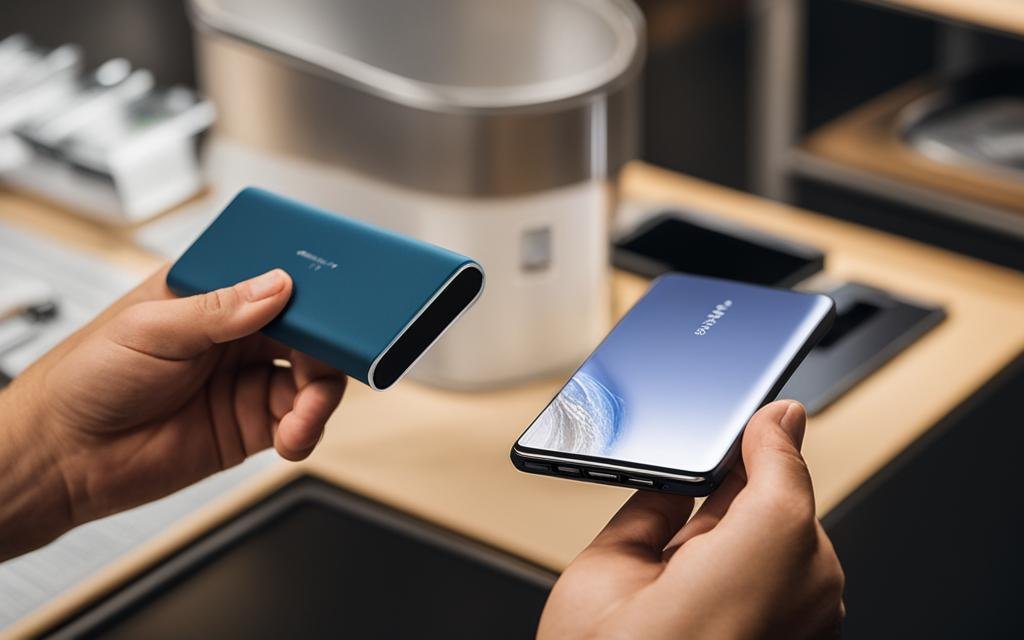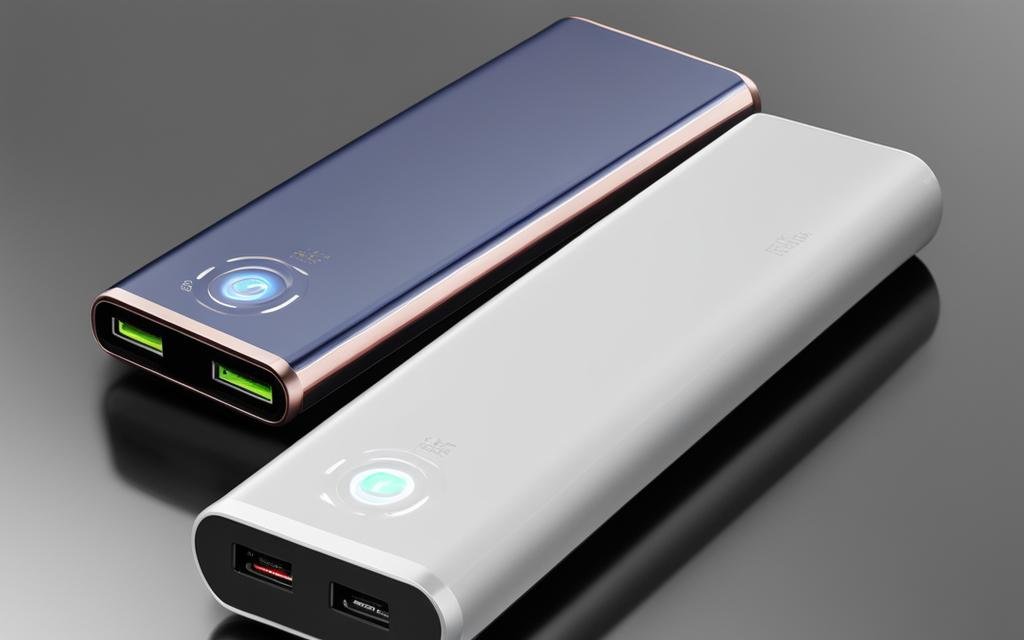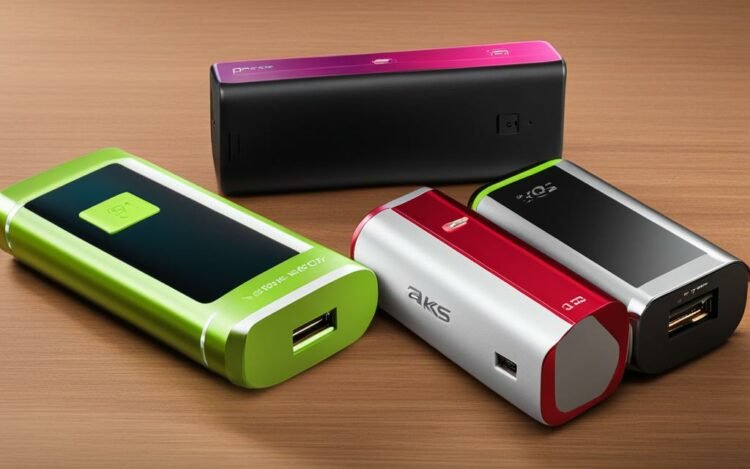As the demand for portable power banks continues to grow, so does the risk of counterfeit products flooding the market. Using a counterfeit power bank can pose serious safety risks to both your devices and yourself. Therefore, it is crucial to be able to spot fake power banks and distinguish them from genuine ones.
In this section, we will provide you with key indicators to look out for when identifying a counterfeit power bank. By knowing how to detect fake power banks, you can ensure the safety and optimal performance of your valuable devices.
Some of the signs of a counterfeit power bank include low-quality materials, imperfect finishing, and a lack of certifications or safety standards. These factors can negatively impact the performance of the power bank and potentially cause harm to your devices or yourself.
To distinguish genuine and counterfeit power banks, you need to look beyond the superficial details. This means examining the packaging, build quality, performance, and safety certifications. By doing so, you can ensure that you are purchasing a high-quality and safe device.
Now, let’s dive deeper into the risks associated with counterfeit power banks and the steps to detect fake power banks. By following the tips outlined in this article, you can protect yourself and your devices against potential hazards.
Understanding the Risks of Counterfeit Power Banks
Using counterfeit power banks can pose serious risks to both your devices and yourself. The market for counterfeit power banks is growing, and it’s important to be able to identify them to safeguard your belongings and your wellbeing. Counterfeit power banks can overheat, explode, and cause damage to your devices.
One of the biggest dangers is their potential for overheating. Counterfeit power banks often use poor quality materials and skip necessary safety checks to cut costs. This can result in a power bank that overheats during charging or use, putting your device at risk of damage or fire. Additionally, counterfeit power banks often have lower-quality battery cells that can also lead to overheating.
Explosions can also occur with counterfeit power banks. A low-quality power bank can explode due to poorly made or damaged battery cells. Explosions can cause serious injury or damage to your property, making it important to be able to identify counterfeit power banks before using them.
It’s also worth noting that counterfeit power banks don’t necessarily have to pose an immediate risk to your devices or safety to be dangerous. Using a counterfeit power bank can cause damage to your device’s battery over time, resulting in a shorter lifespan and the need for more frequent replacements. This can be costly and inconvenient in the long run.
Overall, it’s crucial to be able to identify counterfeit power banks to protect yourself and your belongings. In the following sections, we’ll provide guidance on how to detect counterfeit power banks by examining packaging, quality, performance, and safety standards to ensure that the power bank you’re purchasing is authentic and safe to use.
Examining Packaging and Branding
When it comes to distinguishing between genuine and counterfeit power banks, packaging and branding can be key indicators. Branding details such as logos, fonts, and colors can provide clues to help you determine if a power bank is authentic or fake. Here are some factors to consider:
- Logo: Check the logo carefully for any inconsistencies or variations from the brand’s official logo. If the logo looks distorted or pixelated, it could be a sign of a counterfeit power bank.
- Font: Look closely at the font used for the branding details. If the font is different from what is used on the brand’s official website or packaging, it may be a sign of a fake power bank.
- Colors: Check the colors used on the power bank’s packaging and branding against the brand’s official colors. If the colors are different or appear faded, it could indicate that the power bank is counterfeit.
Remember that some counterfeit power banks may have packaging that appears identical to a genuine power bank. In these cases, it is essential to examine the power bank itself for other signs of counterfeiting.

Checking for Quality and Build
When trying to identify fake power banks, checking the quality and build of the device is crucial. A counterfeit power bank is likely to have a poor quality build, which can give a potential sign of a counterfeit power bank.
One way to check the quality of a power bank is to look at the materials used in making it. Genuine power banks usually use high-quality materials that are durable and hard-wearing. A counterfeit power bank, on the other hand, may have a cheap and flimsy feel to it. Additionally, look out for any visible signs of wear and tear, such as scratches or dents, as these can indicate that the power bank is not genuine.
Another way to determine the quality of a power bank is to examine the finishing. Genuine power banks typically have a smooth and well-polished finish. A counterfeit power bank may have uneven edges or rough seams that can indicate a lack of attention to detail.
When examining the quality and build of a power bank, pay attention to the construction of the device. Genuine power banks are usually assembled with precision, and the individual parts fit together seamlessly. In contrast, a counterfeit power bank may have a loose fit or visible gaps between the parts. This may be a sign of a counterfeit power bank.
Examples of low-quality and counterfeit power banks
- A power bank that has a plastic casing that feels flimsy and cheap to the touch
- A power bank that has rough seams or visible gaps between the parts
- A power bank that has a loose or poorly fitting battery cover
- A power bank that has visible defects such as scratches, dents or discoloration
By examining the quality and build of a power bank, you can identify some of the common signs of a counterfeit power bank. Remember, quality is one of the most critical factors to consider when purchasing a power bank, and a low-quality or counterfeit device can pose serious risks to your devices and yourself.
Verifying Certification and Safety Standards
When it comes to choosing a power bank, you want to make sure it is safe and meets quality standards. Genuine power banks undergo rigorous testing and adhere to safety standards. However, counterfeit power banks may not meet these standards, which can result in safety hazards.
One way to identify authentic power banks is to look for certification marks. These marks indicate that the power bank has been tested and meets certain safety and quality standards. Common certification marks include UL, CE, FCC, and RoHS.
It is important to note that counterfeit power banks may also include fake certification marks. Therefore, it is crucial to verify the mark by checking the official certification database. You can find a list of certified products on the respective organization’s website.
Another way to ensure authenticity is to check for safety standards compliance. Safety standards such as IEC/EN 62133, UN 38.3, and IEC/EN 60950-1 ensure the power bank meets safety requirements.
When comparing authentic vs fake power banks, it is important to remember that counterfeit power banks may not adhere to safety and quality standards. By verifying certification and safety standards, you can ensure that the power bank you are considering is not a counterfeit, and you can be confident that you are purchasing a safe and authentic product.

Checking Performance and Capacity
Counterfeit power banks often have inferior performance and capacity compared to genuine ones. To ensure you are getting what you paid for, it is essential to check the performance and capacity of a power bank before purchasing it.
To check the performance of a power bank, start by testing its charging speed. Connect it to your device and note how quickly it charges. Genuine power banks charge faster than counterfeit ones, so if you notice a significant difference in charging time, that might be an indication of a fake.
You can also check the capacity of the power bank. This information should be available in the manufacturer’s specifications. If the actual capacity is much lower than what is advertised, that is another tell-tale sign of a counterfeit.
It is important to note that performance and capacity are not the only indicators of a fake power bank. Always take into consideration the packaging, branding, quality, and safety standards of the power bank as well.
Testing the Charging Speed
To test the charging speed of a power bank, follow these steps:
- Connect the power bank to your device using a compatible cable.
- Note the starting battery level of your device.
- Start charging your device and note the time it takes to reach a full charge.
- Compare the charging time with the manufacturer’s specifications.
If the charging time is significantly longer than what is advertised, it might be a sign of a fake power bank.
Checking the Capacity
To check the capacity of a power bank, follow these steps:
- Check the manufacturer’s specifications for the power bank’s capacity.
- Charge the power bank to full capacity.
- Use the power bank to charge your device until it runs out of power.
- Note the total charging time and calculate the actual output capacity of the power bank.
- Compare the actual output capacity with the manufacturer’s specifications.
If the actual capacity is much lower than what is advertised, it might be a sign of a fake power bank.
Conclusion
As you have learned, being able to spot fake or counterfeit power banks is essential for the safety and well-being of your devices and yourself. The risks associated with using counterfeit power banks can range from device damage to serious injury or even death.
By following the guidelines provided in this article, you can distinguish between genuine and counterfeit power banks more effectively. You can look for signs in the packaging and branding, examine for quality and build, verify certifications and safety standards, and check the power bank’s performance and capacity.
Stay Safe and Be Vigilant
Remember to prioritize safety and quality when purchasing a power bank. Whether you buy online or in-store, do your research and choose reputable brands and retailers. If you are unsure, ask for proof of certification and test the power bank before use.
By staying informed and vigilant, you can reduce the risk of using counterfeit power banks and protect your devices and wellbeing. Always remember that safety comes first, and investing in a genuine power bank will give you peace of mind knowing that you are using a reliable and safe device.
Pro Tip: Want to upgrade your gadgets without breaking the bank and still have some cash left over for those other must-have items on your wishlist? Well, you’re in luck! Explore our Anker discounts and discover a treasure trove of great deals on tech essentials that will leave you feeling like a savvy shopper extraordinaire.
FAQ
How can I spot a fake or counterfeit power bank?
To spot a fake or counterfeit power bank, there are several key indicators to look out for. These include examining the packaging and branding details, checking for quality and build, verifying certifications and safety standards, and evaluating performance and capacity. By following these guidelines, you can increase your chances of identifying a counterfeit power bank.
What are the risks associated with using counterfeit power banks?
Using counterfeit power banks can pose serious risks to the safety of your devices and yourself. These risks include the potential for overheating, explosions, and damage to your devices. It is important to be aware of these dangers and take steps to protect yourself by only using genuine power banks.
How can I examine the packaging and branding to determine if a power bank is genuine or counterfeit?
When examining the packaging and branding of a power bank, pay attention to logos, fonts, and colors. Look for any inconsistencies or poor quality printing. Genuine power banks often have clear and well-executed branding elements, while counterfeit ones may have blurry logos or misspelled words. Additionally, check if the packaging has any security seals or holograms that can be verified with the manufacturer.
What should I look for when checking the quality and build of a power bank?
When checking the quality and build of a power bank, pay attention to the materials used, finishing, and overall construction. Genuine power banks are often made with high-quality materials and have sturdy build. Counterfeit power banks may have rough edges, loose parts, or a flimsy feel. Additionally, compare the power bank’s weight and size to the specifications provided by the manufacturer.
How can I verify certifications and safety standards for a power bank?
To verify certifications and safety standards for a power bank, look for marks such as UL, CE, or FCC. These certifications indicate that the power bank has undergone testing and meets certain safety requirements. It is important to note that some counterfeit power banks may feature fake certification marks, so it’s recommended to cross-check with the respective certification organizations.
How can I check the performance and capacity of a power bank?
To check the performance and capacity of a power bank, you can test the charging speed and compare it to the manufacturer’s specifications. Use a device with a known battery capacity and monitor the time it takes to charge. If the charging speed is significantly slower than expected, it may be an indication of a counterfeit power bank with lower performance and capacity.

